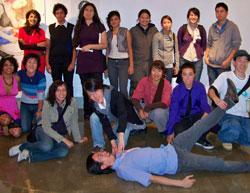“We’re running our own shit and we’re telling you how it is,” says Kenji Tokawa, summing up the ethos behind Asian Arts Freedom School, a radical grassroots organization for Asian youth.
“Freedom School is about learning about our histories,” says trans-identified Tokawa, one of the program coordinators. “Not the histories that are taught in school; not the histories that are appropriated and stereotyped on television and through media. It’s our radical Asian history.”
Inspired by the 1950s and ’60s freedom schools of the African-American civil rights movements, Asian Arts Freedom School is a place for Asian youth to learn, teach and explore revolutionary Asian history through various forms of art.
Freedom School defines Asian in the broadest possible sense. “Our definition of Asian is radically different than definitions that circulate around here. We’re talking about the whole continent,” says Tokawa, adding that the program encourages participants from the Middle East, Southeast Asia and Pacific Islanders, as well as mixed race people and adoptees.
It would be an understatement to say Freedom School is gay-friendly; Wong estimates that around three quarters of the youth involved are queer.
“It was a welcoming space for me to be able to think about and explore my queerness and coming to terms with identifying as trans,” says Tokawa.
“It’s a place to find community; to find other queer people of colour, other Asian activists who are interested in the arts,” says cofounder and multimedia artist Gein Wong. “That’s what Asian Arts Freedom School was; to fill that void.”
The seed for the project began with a conversation in 2003 between Wong, Rose Kazi of the hip hop group Lal and beat boxer Nikhil “Jugular” Tumne. Together they organized a show at the now defunct 360 Bar on Queen St.
After much networking the initiative turned into a successful pilot project-type writing workshop at the Centre for Women and Trans People at the University of Toronto. By 2005 the school offered its first full summer program, facilitated by Wong and poet Leah Lakshmi Piepzna-Samarasinha.
Now in its seventh cycle — the organization’s equivalent of a semester — Freedom School now has around 25 participants, expanded programs and staff. Former participants Tokawa and Elvina Rafi are now paid program coordinators and Patrick Salvani is facilitating the current cycle’s workshops.
“It’s a strong sign that the school will survive — it’s not dependent on one person — but that it will grow,” says Wong.
Freedom School now offers three programs: writing and performance workshops, visual arts workshops (to be held at the Art Gallery of Ontario starting in the fall) and writing workshops for genderqueer and trans people of colour (GenderFOC, held in the month of August).
The school has found financial support for its projects from both queer and mainstream quarters. It has received grants from Artreach Toronto, the Toronto Arts Council, the City of Toronto and the Ontario Arts Council as well as the Community One Foundation (formerly the Lesbian and Gay Community Appeal). It has also been the beneficiary of the drag cabaret event Colour Me Dragg.
Supporting Our Youth (SOY) is Freedom School’s trustee. “SOY handles the money we receive from grantors,” says Tokawa. “So they dispense our cheques. Without an established trustee it is harder to get grants. Grantors trust established organizations more with the money they are awarding, than smaller relatively unknown group.”
“SOY have been really good mentors,” says Wong. “We love them and really appreciate them.”
Wong says that in addition to being a place for young Asian queers to connect, Freedom School is also building support for queer issues among Toronto’s Asian communities.
“There are people who have become really strong straight allies just from being at the school and being around people, and having it become a very humanizing thing to see and hear queer voices and learn about queer history,” she says.

 Why you can trust Xtra
Why you can trust Xtra


